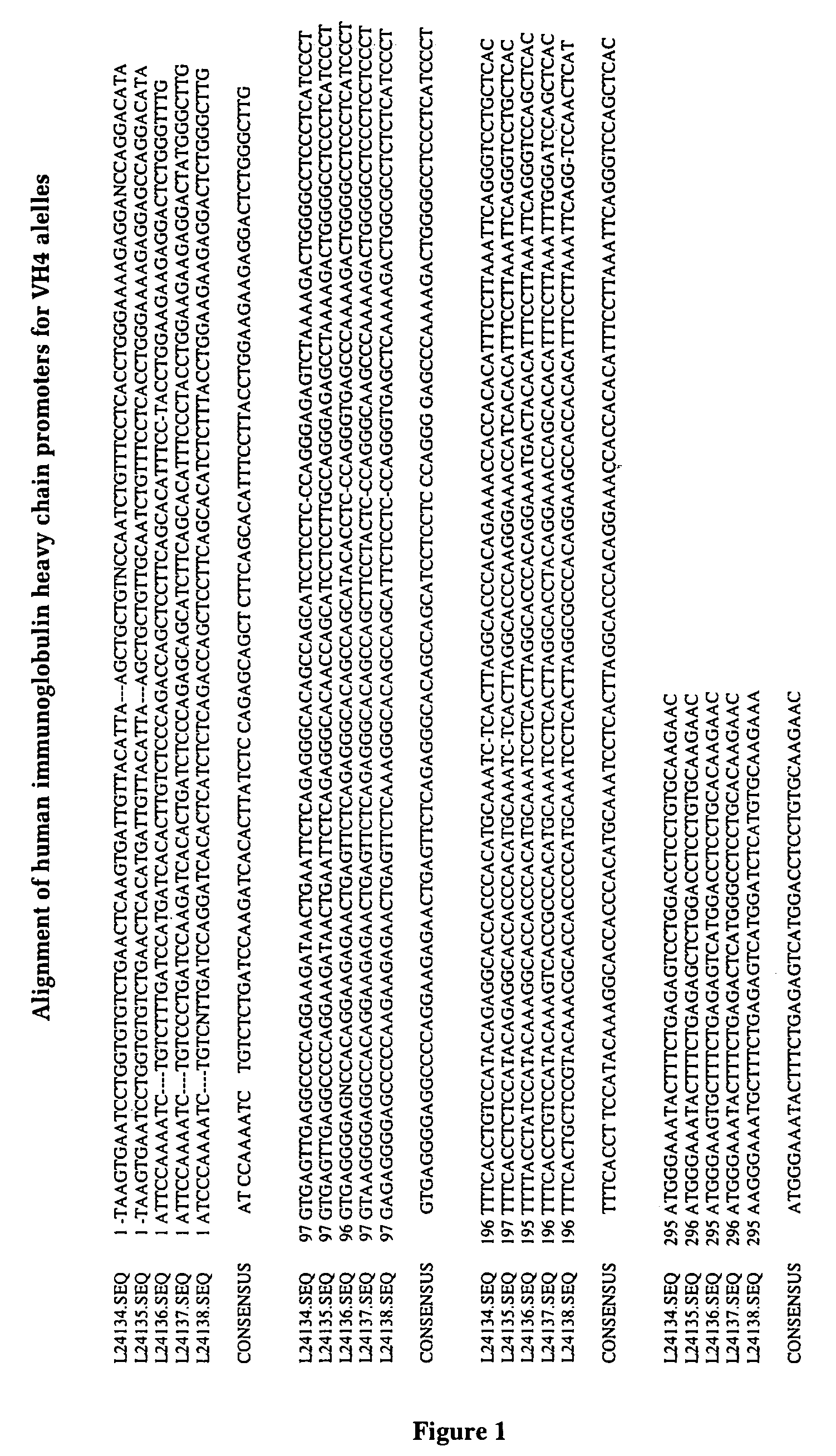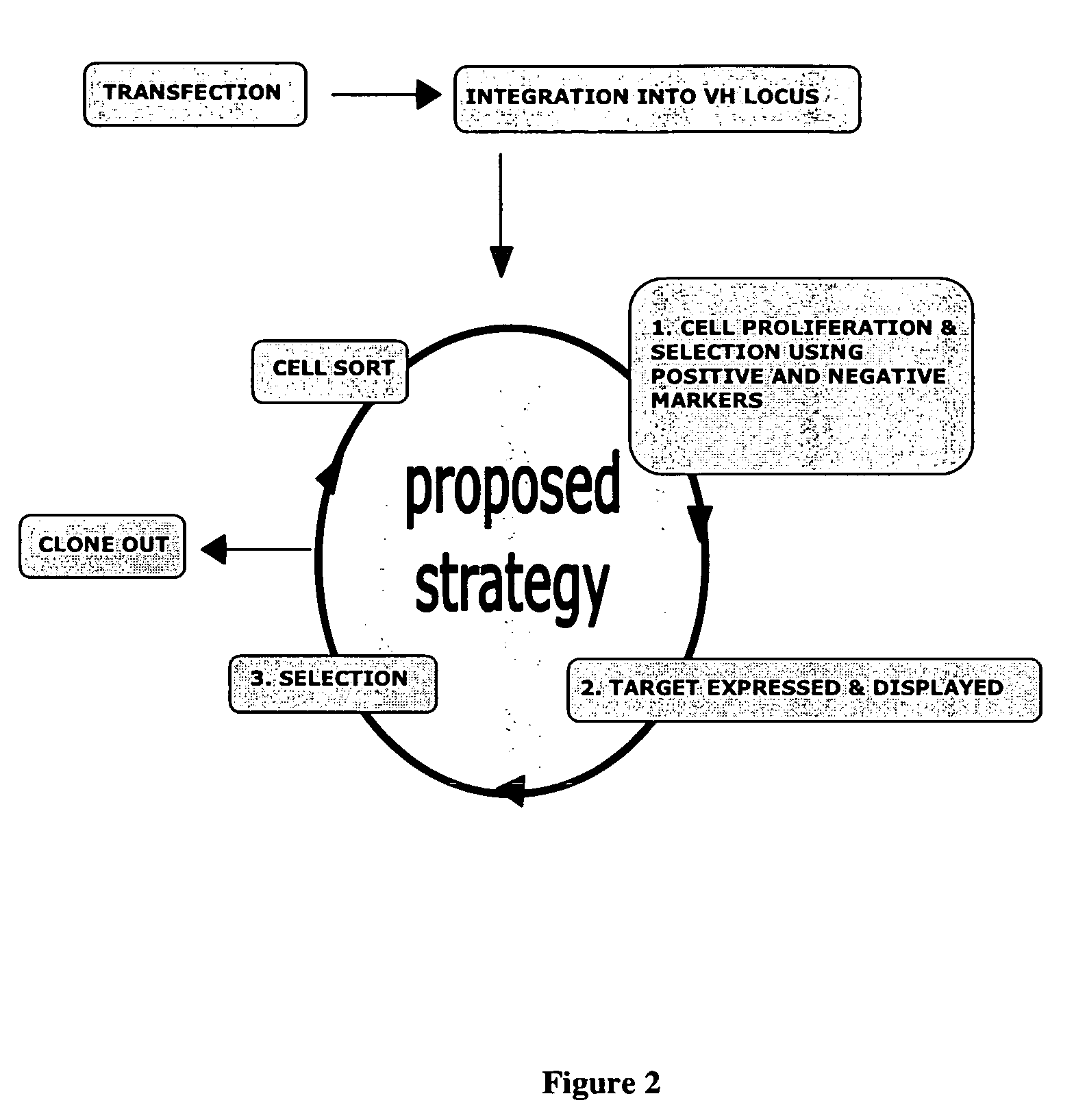In vivo affinity maturation scheme
a nucleic acid and affinity maturation technology, applied in combinational chemistry, chemical libraries, libraries, etc., can solve the problems of limited potential of such processes, limited subsequent transformation efficiency, and loss of diversity, so as to facilitate the recovery of mutant target nucleic acid sequences, improve the affinity of antibodies, and low affinities
- Summary
- Abstract
- Description
- Claims
- Application Information
AI Technical Summary
Benefits of technology
Problems solved by technology
Method used
Image
Examples
example 1
Defining a region in RAMOS Cells for Integration of Target Genes
Methods & Materials
Cell Line and Cell Culture Conditions
[0216] The RAMOS strain RA 1 was obtained from the American Tissue Culture Collection (ATCC-CLR-1596). This strain is IgM positive and expresses the interleukin 4 (IL-4) and CD23 receptors. Cells were maintained in RPMI 1640 medium (Gibco BRL) supplemented with 10% heat inactivated fetal calf serum (FCS) and penicillin (100 U / ml) and streptomycin (100 μg / ml), and incubated at 37° C. with 5% CO2.
Extraction of DNA from Cells
[0217] Cells were harvested and centrifuged at 1500 rpm and resuspended in PBS. DNA was extracted from cells using a Genoprep DNA isolation kit (Scientifix, Australia) according to manufacturer's instructions. Briefly, after removing the supernatant 375 μl of lysis and binding solution was added to cells (5×105), together with 20 μl Genoprep DNA magnetic beads. This mixture was vortexed for five seconds then incubated at room temperature f...
example 2
Design and Construction of a Vector for Integration into the Rearranged VH Allele, VH4-34 in RAMOS RA-1
1) Construction of Vector for Integration
[0238] A 3 kb fragment, containing sequence homologous to the region downstream of the rearranged allele VH4-34 was amplified from the construct 3 kbPCRScript 10-1-3 with the forward primer 9879 (5′ CGGCTGATATCTGGGAGCCTCTGTGGATTTTCCGA 3′) (SEQ ID NO:83) and the reverse primer 9805 (5′ AGCCGGATATCGCCCAGCCCAGCCTAGCTCA 3′) (SEQ ID NO:84) using Platinum PfX DNA polymerase (Invitrogen, Calif. USA). PCR products were purified using QIAquick PCR Purification Kit (Qiagen™) according to manufacturer's instructions then digested with EcoRV and ethanol precipitated. Digested fragments were ligated into construct 5 kbPCRScript 15a-7 containing the 5 kb sequence upstream of the rearranged VH allele. The DNA was transformed into Escherichia coli and grown at 37° C. overnight.
[0239] Bacterial colonies were screened by Southern blotting and probed using...
example 3
Design and Construction of a Vector for Integration into the Rearranged VH Allele, VH4-34 in RAMOS RA-1 and Mutation of the asFP499 Gene
[0244] The components of the vector for integration are as follows:
[0245] i) Construct 5 kb in PCRScript 15a-7 is modified by removing the Nae I-Xho I fragment which effectively deletes an additional Kpn I site. This new construct is herein referred to as 5 kbPCRScript minus Nae I-Xho I and is 7608 bp in length.
[0246] ii) The cloned gene for asFP499, which is a fluorescent protein isolated from the sea anemone Anemonia sulcata, was obtained from J. Wiedenmann (University of Ulm, Germany) in the plasmid pQE32 (Qiagen, Calif. USA). Four sequential PCR reactions were performed to introduce restriction sites Kpn I and Not I at the, 5′ and 3′ ends of the asFP499 gene respectively and two C-terminal flag tags with a Sal I site at the 3′ end of the second flag tag. This final product (˜770 bp) is subcloned into pPCRscript (Stratagene, Tex., USA) and her...
PUM
| Property | Measurement | Unit |
|---|---|---|
| volume | aaaaa | aaaaa |
| temperatures | aaaaa | aaaaa |
| volume | aaaaa | aaaaa |
Abstract
Description
Claims
Application Information
 Login to View More
Login to View More - R&D
- Intellectual Property
- Life Sciences
- Materials
- Tech Scout
- Unparalleled Data Quality
- Higher Quality Content
- 60% Fewer Hallucinations
Browse by: Latest US Patents, China's latest patents, Technical Efficacy Thesaurus, Application Domain, Technology Topic, Popular Technical Reports.
© 2025 PatSnap. All rights reserved.Legal|Privacy policy|Modern Slavery Act Transparency Statement|Sitemap|About US| Contact US: help@patsnap.com



